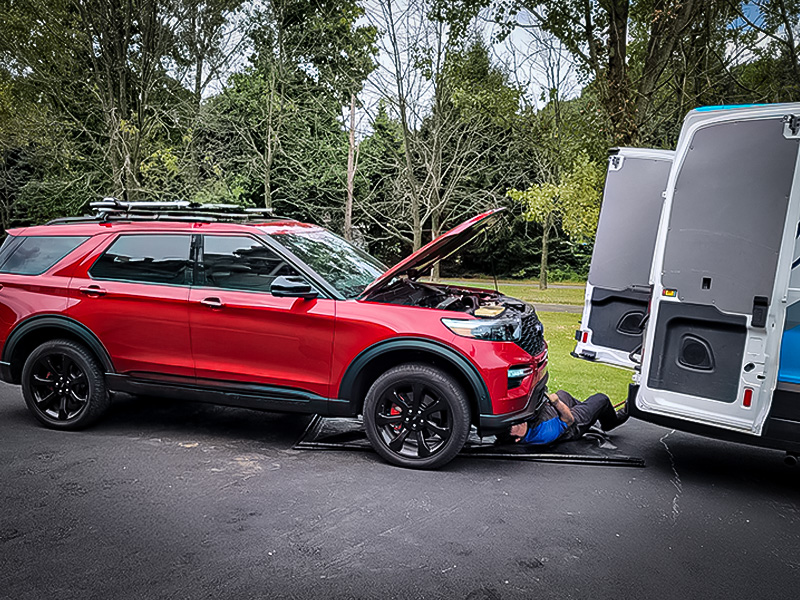Using your shop’s Cost of Doing Business (CODB) as a baseline for labor rates.

I had a great experience recently when my dealer’s service department called to ask if I’d like to schedule some routine maintenance needed on my SUV from one of their fleet of nifty new mobile service vans, with the promise that my cost would be the same as if I brought my vehicle to the dealer’s service department. I accepted, because why wouldn’t I?
On the appointed Wednesday and right on time, a shiny custom van showed up carrying two neatly-uniformed technicians. After a quick meet and greet on my driveway and a review of their to-do list, they went straight to their work, and I resumed mine—in the tomblike silence of my home office, seated in my own comfy chair, sipping my own fussy dark roast coffee, blissfully free of the distractions that plague even the bougiest of customer lounges.
Forty-five minutes later and just a few moments after I’d received a text with a link to a brief narrated show-and-tell video of their work, the technicians were done. We spent a few minutes chatting while I peered inside their clinically-clean service bay on wheels. Then I signed off on their invoice, paid the digital bill, and off they went to their next stop.
Conceptually, mobile service was novel to me, but it’s far from new. Shop Press Editor-in-Chief and resident motorcycle maniac Lemmy says the Harley-Davidson Servi-Car, launched during the Great Depression, might very well have been one of the first examples of roadside assistance for automobiles. My immediate reaction to this tidbit of automotive history was that sending a Harley to repair a broken-down car in the early 1930s would be like going to Jennifer Lopez for marriage counseling today. For some reason, my sarcasm seemed lost on my esteemed colleague.
That said, mobile service has only recently been gaining momentum in our industry, and as you’d expect, the majority of the growth is among well-heeled manufacturers like Tesla, Ford, Mercedes-Benz, and others. The price of entry to be able to provide the wide range of mobile repair services the big boys offer is surely a high barrier for smaller independent shops to hurdle: One of the techs estimated that their van cost well into six figures including its very slick and space-efficient interior layout and tools. On top of that capital expense, there’s a whole different (and costly) level of liability exposure and insurance to consider, along with the internal logistics (e.g., recruiting and training the staff required) and external practicalities (e.g., sloped driveways, urban congestion) to introduce a mobile operation.
There is, however, a growing market out there for shops and other businesses that want to take the leap, or companies that outfit slick mobile service vans that rival the ones the dealers are deploying, such as Bush Specialty Vehicles, wouldn’t exist.
Still, I think there’s a new business niche here for some smaller established independent shops in densely populated areas. Even a small repair center could see a decent return on a limited investment if their mobile venture is more focused than that of the big guys. Namely, routine scheduled maintenance along with straightforward, predictable repairs that don’t require toting a warehouse’s worth of dissimilar parts and the tools to install them. Check out, for example, Ty The Car Guy, a successful mobile mechanic who shot this revealing behind-the-scenes video and a candid conversation with the owner of a traditional shop.
For ambitious entrepreneurs already good at wrenching, there’s also the solo mobile mechanic route. AutoLeap has a good starter guide if you’ve got the right stuff to be your own boss.

Mobile service technicians rotating tires. Photo: Mike Principato.
If you’re the owner of an independent repair shop, the road to successfully adding mobile service has to begin with your realistic assessment of the specific repairs and maintenance work you can profitably offer to current and future customers. Here’s a starter list of the possibilities that don’t require a specialized vehicle or a significant investment in specialized tools or equipment beyond what you already own or can inexpensively acquire (e.g., a floor jack and four stands for tire rotations):

Oil and filter change? Yes, please. Photo: Mike Principato.
One thing’s for sure: the trend toward delivered-to-your-door convenience is growing. The dealership that services my Explorer has grown its fleet of mobile units from one to seven in one year. And according to the traveling techs who’ve been to my house on three separate occasions over the last year for routine maintenance, they’re booked solid five days a week. With so many folks working remotely, who wouldn’t choose skipping the trip to the dealership to carve out a few more hours of productivity? Not to mention being able to enjoy better coffee.
I smell an opportunity here. Do you?
The articles and other content contained on this site may contain links to third party websites. By clicking them, you consent to Dorman’s Website Use Agreement.
Participation in this forum is subject to Dorman’s Website Terms & Conditions. Please read our Comment Policy before commenting.